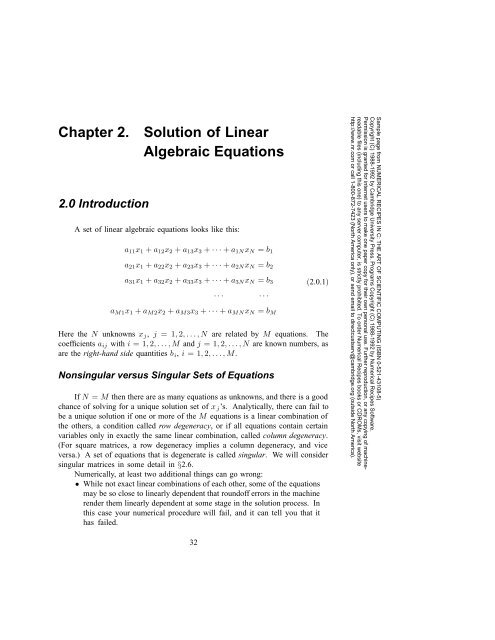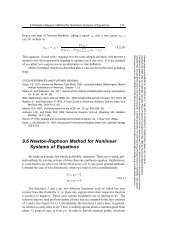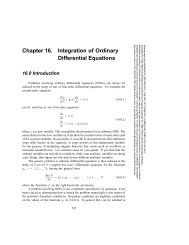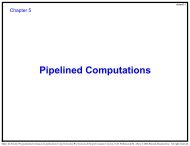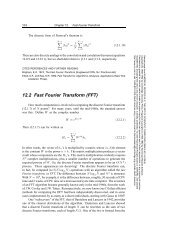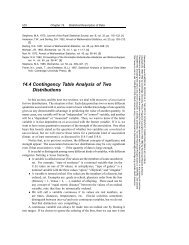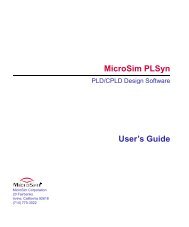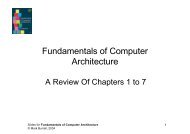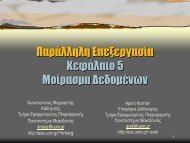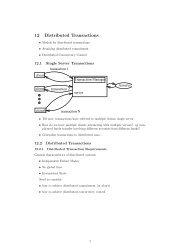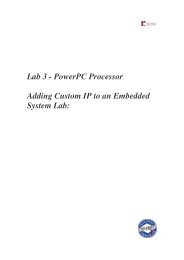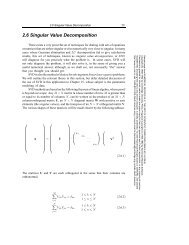Chapter 2. Solution of Linear Algebraic Equations 2.0 Introduction
Chapter 2. Solution of Linear Algebraic Equations 2.0 Introduction
Chapter 2. Solution of Linear Algebraic Equations 2.0 Introduction
Create successful ePaper yourself
Turn your PDF publications into a flip-book with our unique Google optimized e-Paper software.
<strong>Chapter</strong> <strong>2.</strong><strong>2.</strong>0 <strong>Introduction</strong><strong>Solution</strong> <strong>of</strong> <strong>Linear</strong><strong>Algebraic</strong> <strong>Equations</strong>A set <strong>of</strong> linear algebraic equations looks like this:a 11 x 1 + a 12 x 2 + a 13 x 3 + ···+ a 1N x N = b 1a 21 x 1 + a 22 x 2 + a 23 x 3 + ···+ a 2N x N = b 2a 31 x 1 + a 32 x 2 + a 33 x 3 + ···+ a 3N x N = b 3 (<strong>2.</strong>0.1)··· ···a M1 x 1 + a M2 x 2 + a M3 x 3 + ···+ a MN x N = b MHere the N unknowns x j , j =1, 2,...,N are related by M equations. Thecoefficients a ij with i =1, 2,...,M and j =1, 2,...,N are known numbers, asare the right-hand side quantities b i , i =1, 2,...,M.Nonsingular versus Singular Sets <strong>of</strong> <strong>Equations</strong>If N = M then there are as many equations as unknowns, and there is a goodchance <strong>of</strong> solving for a unique solution set <strong>of</strong> x j ’s. Analytically, there can fail tobe a unique solution if one or more <strong>of</strong> the M equations is a linear combination <strong>of</strong>the others, a condition called row degeneracy, or if all equations contain certainvariables only in exactly the same linear combination, called column degeneracy.(For square matrices, a row degeneracy implies a column degeneracy, and viceversa.) A set <strong>of</strong> equations that is degenerate is called singular. We will considersingular matrices in some detail in §<strong>2.</strong>6.Numerically, at least two additional things can go wrong:• While not exact linear combinations <strong>of</strong> each other, some <strong>of</strong> the equationsmay be so close to linearly dependent that round<strong>of</strong>f errors in the machinerender them linearly dependent at some stage in the solution process. Inthis case your numerical procedure will fail, and it can tell you that ithas failed.Sample page from NUMERICAL RECIPES IN C: THE ART OF SCIENTIFIC COMPUTING (ISBN 0-521-43108-5)Copyright (C) 1988-1992 by Cambridge University Press. Programs Copyright (C) 1988-1992 by Numerical Recipes S<strong>of</strong>tware.Permission is granted for internet users to make one paper copy for their own personal use. Further reproduction, or any copying <strong>of</strong> machinereadablefiles (including this one) to any server computer, is strictly prohibited. To order Numerical Recipes books or CDROMs, visit websitehttp://www.nr.com or call 1-800-872-7423 (North America only), or send email to directcustserv@cambridge.org (outside North America).32
34 <strong>Chapter</strong> <strong>2.</strong> <strong>Solution</strong> <strong>of</strong> <strong>Linear</strong> <strong>Algebraic</strong> <strong>Equations</strong>at this point. Occasionally it is useful to be able to peer through the veil, for exampleto pass a whole row a[i][j], j=1,...,N by the reference a[i].Tasks <strong>of</strong> Computational <strong>Linear</strong> AlgebraWe will consider the following tasks as falling in the general purview <strong>of</strong> thischapter:• <strong>Solution</strong> <strong>of</strong> the matrix equation A·x = b for an unknown vector x, where Ais a square matrix <strong>of</strong> coefficients, raised dot denotes matrix multiplication,and b is a known right-hand side vector (§<strong>2.</strong>1–§<strong>2.</strong>10).• <strong>Solution</strong> <strong>of</strong> more than one matrix equation A · x j = b j , for a set <strong>of</strong> vectorsx j , j =1, 2,..., each corresponding to a different, known right-hand sidevector b j . In this task the key simplification is that the matrix A is heldconstant, while the right-hand sides, the b’s, are changed (§<strong>2.</strong>1–§<strong>2.</strong>10).• Calculation <strong>of</strong> the matrix A −1 which is the matrix inverse <strong>of</strong> a square matrixA, i.e., A · A −1 = A −1 · A = 1, where 1 is the identity matrix (all zerosexcept for ones on the diagonal). This task is equivalent, for an N × Nmatrix A, to the previous task with N different b j ’s (j =1, 2,...,N),namely the unit vectors (b j = all zero elements except for 1 in the jthcomponent). The corresponding x’s are then the columns <strong>of</strong> the matrixinverse <strong>of</strong> A (§<strong>2.</strong>1 and §<strong>2.</strong>3).• Calculation <strong>of</strong> the determinant <strong>of</strong> a square matrix A (§<strong>2.</strong>3).If M < N, or if M = N but the equations are degenerate, then thereare effectively fewer equations than unknowns. In this case there can be either nosolution, or else more than one solution vector x. In the latter event, the solution spaceconsists <strong>of</strong> a particular solution x p added to any linear combination <strong>of</strong> (typically)N − M vectors (which are said to be in the nullspace <strong>of</strong> the matrix A). The task<strong>of</strong> finding the solution space <strong>of</strong> A involves• Singular value decomposition <strong>of</strong> a matrix A.This subject is treated in §<strong>2.</strong>6.In the opposite case there are more equations than unknowns, M>N. Whenthis occurs there is, in general, no solution vector x to equation (<strong>2.</strong>0.1), and the set<strong>of</strong> equations is said to be overdetermined. It happens frequently, however, that thebest “compromise” solution is sought, the one that comes closest to satisfying allequations simultaneously. If closeness is defined in the least-squares sense, i.e., thatthe sum <strong>of</strong> the squares <strong>of</strong> the differences between the left- and right-hand sides <strong>of</strong>equation (<strong>2.</strong>0.1) be minimized, then the overdetermined linear problem reduces toa (usually) solvable linear problem, called the• <strong>Linear</strong> least-squares problem.The reduced set <strong>of</strong> equations to be solved can be written as the N ×N set <strong>of</strong> equationsSample page from NUMERICAL RECIPES IN C: THE ART OF SCIENTIFIC COMPUTING (ISBN 0-521-43108-5)Copyright (C) 1988-1992 by Cambridge University Press. Programs Copyright (C) 1988-1992 by Numerical Recipes S<strong>of</strong>tware.Permission is granted for internet users to make one paper copy for their own personal use. Further reproduction, or any copying <strong>of</strong> machinereadablefiles (including this one) to any server computer, is strictly prohibited. To order Numerical Recipes books or CDROMs, visit websitehttp://www.nr.com or call 1-800-872-7423 (North America only), or send email to directcustserv@cambridge.org (outside North America).(A T · A) · x =(A T · b) (<strong>2.</strong>0.4)where A T denotes the transpose <strong>of</strong> the matrix A. <strong>Equations</strong> (<strong>2.</strong>0.4) are called thenormal equations <strong>of</strong> the linear least-squares problem. There is a close connection
<strong>2.</strong>0 <strong>Introduction</strong> 35between singular value decomposition and the linear least-squares problem, and thelatter is also discussed in §<strong>2.</strong>6. You should be warned that direct solution <strong>of</strong> thenormal equations (<strong>2.</strong>0.4) is not generally the best way to find least-squares solutions.Some other topics in this chapter include• Iterative improvement <strong>of</strong> a solution (§<strong>2.</strong>5)• Various special forms: symmetric positive-definite (§<strong>2.</strong>9), tridiagonal(§<strong>2.</strong>4), band diagonal (§<strong>2.</strong>4), Toeplitz (§<strong>2.</strong>8), Vandermonde (§<strong>2.</strong>8), sparse(§<strong>2.</strong>7)• Strassen’s “fast matrix inversion” (§<strong>2.</strong>11).Standard Subroutine PackagesWe cannot hope, in this chapter or in this book, to tell you everything there is toknow about the tasks that have been defined above. In many cases you will have noalternative but to use sophisticated black-box program packages. Several good onesare available, though not always in C. LINPACK was developed at Argonne NationalLaboratories and deserves particular mention because it is published, documented,and available for free use. A successor to LINPACK, LAPACK, is now becomingavailable. Packages available commercially (though not necessarily in C) includethose in the IMSL and NAG libraries.You should keep in mind that the sophisticated packages are designed with verylarge linear systems in mind. They therefore go to great effort to minimize not onlythe number <strong>of</strong> operations, but also the required storage. Routines for the varioustasks are usually provided in several versions, corresponding to several possiblesimplifications in the form <strong>of</strong> the input coefficient matrix: symmetric, triangular,banded, positive definite, etc. If you have a large matrix in one <strong>of</strong> these forms,you should certainly take advantage <strong>of</strong> the increased efficiency provided by thesedifferent routines, and not just use the form provided for general matrices.There is also a great watershed dividing routines that are direct (i.e., executein a predictable number <strong>of</strong> operations) from routines that are iterative (i.e., attemptto converge to the desired answer in however many steps are necessary). Iterativemethods become preferable when the battle against loss <strong>of</strong> significance is in danger<strong>of</strong> being lost, either due to large N or because the problem is close to singular. Wewill treat iterative methods only incompletely in this book, in §<strong>2.</strong>7 and in <strong>Chapter</strong>s18 and 19. These methods are important, but mostly beyond our scope. We will,however, discuss in detail a technique which is on the borderline between directand iterative methods, namely the iterative improvement <strong>of</strong> a solution that has beenobtained by direct methods (§<strong>2.</strong>5).CITED REFERENCES AND FURTHER READING:Golub, G.H., and Van Loan, C.F. 1989, Matrix Computations, 2nd ed. (Baltimore: Johns HopkinsUniversity Press).Gill, P.E., Murray, W., and Wright, M.H. 1991, Numerical <strong>Linear</strong> Algebra and Optimization, vol. 1(Redwood City, CA: Addison-Wesley).Stoer, J., and Bulirsch, R. 1980, <strong>Introduction</strong> to Numerical Analysis (New York: Springer-Verlag),<strong>Chapter</strong> 4.Dongarra, J.J., et al. 1979, LINPACK User’s Guide (Philadelphia: S.I.A.M.).Sample page from NUMERICAL RECIPES IN C: THE ART OF SCIENTIFIC COMPUTING (ISBN 0-521-43108-5)Copyright (C) 1988-1992 by Cambridge University Press. Programs Copyright (C) 1988-1992 by Numerical Recipes S<strong>of</strong>tware.Permission is granted for internet users to make one paper copy for their own personal use. Further reproduction, or any copying <strong>of</strong> machinereadablefiles (including this one) to any server computer, is strictly prohibited. To order Numerical Recipes books or CDROMs, visit websitehttp://www.nr.com or call 1-800-872-7423 (North America only), or send email to directcustserv@cambridge.org (outside North America).
36 <strong>Chapter</strong> <strong>2.</strong> <strong>Solution</strong> <strong>of</strong> <strong>Linear</strong> <strong>Algebraic</strong> <strong>Equations</strong>Coleman, T.F., and Van Loan, C. 1988, Handbook for Matrix Computations (Philadelphia: S.I.A.M.).Forsythe, G.E., and Moler, C.B. 1967, Computer <strong>Solution</strong> <strong>of</strong> <strong>Linear</strong> <strong>Algebraic</strong> Systems (EnglewoodCliffs, NJ: Prentice-Hall).Wilkinson, J.H., and Reinsch, C. 1971, <strong>Linear</strong> Algebra, vol. II <strong>of</strong> Handbook for Automatic Computation(New York: Springer-Verlag).Westlake, J.R. 1968, A Handbook <strong>of</strong> Numerical Matrix Inversion and <strong>Solution</strong> <strong>of</strong> <strong>Linear</strong> <strong>Equations</strong>(New York: Wiley).Johnson, L.W., and Riess, R.D. 1982, Numerical Analysis, 2nd ed. (Reading, MA: Addison-Wesley), <strong>Chapter</strong> <strong>2.</strong>Ralston, A., and Rabinowitz, P. 1978, A First Course in Numerical Analysis, 2nd ed. (New York:McGraw-Hill), <strong>Chapter</strong> 9.<strong>2.</strong>1 Gauss-Jordan EliminationFor inverting a matrix, Gauss-Jordan elimination is about as efficient as anyother method. For solving sets <strong>of</strong> linear equations, Gauss-Jordan eliminationproduces both the solution <strong>of</strong> the equations for one or more right-hand side vectorsb, and also the matrix inverse A −1 . However, its principal weaknesses are (i) that itrequires all the right-hand sides to be stored and manipulated at the same time, and(ii) that when the inverse matrix is not desired, Gauss-Jordan is three times slowerthan the best alternative technique for solving a single linear set (§<strong>2.</strong>3). The method’sprincipal strength is that it is as stable as any other direct method, perhaps even abit more stable when full pivoting is used (see below).If you come along later with an additional right-hand side vector, you canmultiply it by the inverse matrix, <strong>of</strong> course. This does give an answer, but one that isquite susceptible to round<strong>of</strong>f error, not nearly as good as if the new vector had beenincluded with the set <strong>of</strong> right-hand side vectors in the first instance.For these reasons, Gauss-Jordan elimination should usually not be your method<strong>of</strong> first choice, either for solving linear equations or for matrix inversion. Thedecomposition methods in §<strong>2.</strong>3 are better. Why do we give you Gauss-Jordan at all?Because it is straightforward, understandable, solid as a rock, and an exceptionallygood “psychological” backup for those times that something is going wrong and youthink it might be your linear-equation solver.Some people believe that the backup is more than psychological, that Gauss-Jordan elimination is an “independent” numerical method. This turns out to bemostly myth. Except for the relatively minor differences in pivoting, describedbelow, the actual sequence <strong>of</strong> operations performed in Gauss-Jordan elimination isvery closely related to that performed by the routines in the next two sections.For clarity, and to avoid writing endless ellipses (···) we will write out equationsonly for the case <strong>of</strong> four equations and four unknowns, and with three different righthandside vectors that are known in advance. You can write bigger matrices andextend the equations to the case <strong>of</strong> N × N matrices, with M sets <strong>of</strong> right-handside vectors, in completely analogous fashion. The routine implemented below is,<strong>of</strong> course, general.Sample page from NUMERICAL RECIPES IN C: THE ART OF SCIENTIFIC COMPUTING (ISBN 0-521-43108-5)Copyright (C) 1988-1992 by Cambridge University Press. Programs Copyright (C) 1988-1992 by Numerical Recipes S<strong>of</strong>tware.Permission is granted for internet users to make one paper copy for their own personal use. Further reproduction, or any copying <strong>of</strong> machinereadablefiles (including this one) to any server computer, is strictly prohibited. To order Numerical Recipes books or CDROMs, visit websitehttp://www.nr.com or call 1-800-872-7423 (North America only), or send email to directcustserv@cambridge.org (outside North America).


